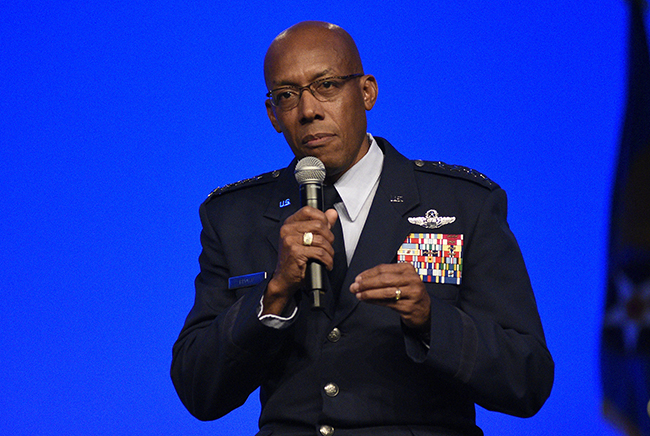
Pacific Air Forces Commander Gen. Charles Q. Brown speaks on a Sept. 18, 2019, panel during AFA's 2019 Air, Space & Cyber Conference in National Harbor, Md., outside of Washington, D.C. Staff photo by Mike Tsukamoto.
Pacific Air Forces is growing its outreach to countries across the Indo-Pacific region to understand what airfields it could use if needed, and is doing so as China also works to spread its own influence.
PACAF boss Gen. Charles Q. Brown said Sept. 18 he’s confident that, with the relationships the US has in the region, including close alliances with major countries like Australia and Japan, “we have a few more options” to wield military power from abroad than China does. He spoke to reporters at AFA’s Air, Space & Cyber Conference.
Brown has traveled to 12 countries in the 14 months he’s been in his current job, going to “most every location that has an Air Force” to build military ties and discuss facilities use. In his previous job as commander of Air Forces Central Command, Brown said he drank a lot of tea, but now conversations take place over “soju, mai tais, and sake.”
One issue is that the entire US military wants to expand its access in the region, so America needs to be careful to not impose all of its military components on a small Pacific nation and overwhelm it, Brown said.
The US will explore its possibilities for access as it leads a Pacific Air Chiefs Symposium representing 22 nations in December.
PACAF in April practiced how it could use some of these airfields in the event of an emergency or natural disaster. In an exercise dubbed “Resilient Typhoon,” F-16s, F-15s, C-17s, F-22s, and their associated personnel quickly dispersed to airfields in locations like the Northern Mariana Islands, the Federated States of Micronesia, and Palau.
The Air Force is increasingly focused on the concept of rapid, adaptive basing that doesn’t rely on established facilities. For PACAF, traversing the distances between various operating locations can be problematic, but the command is training itself to operate without many supplies on hand.
“I just need a runway, a ramp, a weapons trailer, a fuel bladder, and a pallet of [meals, ready to eat],” Brown said. “That’s maybe a little bit bold, but the point is, we’ve got to be light, lean, and agile.”